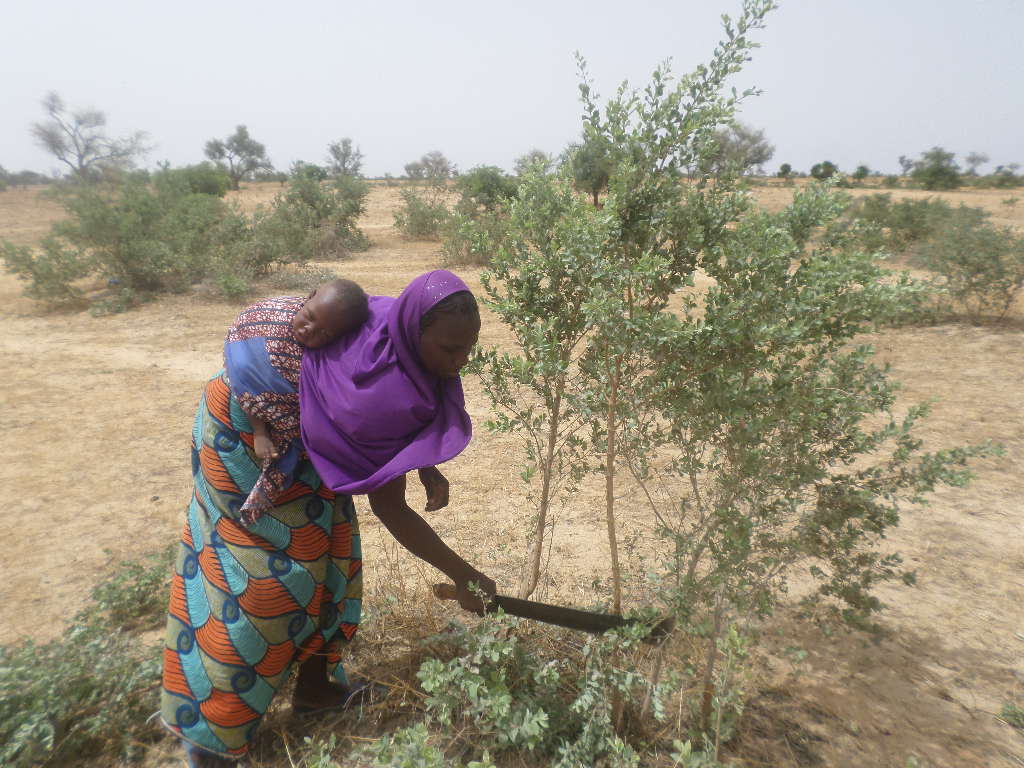Pictured above: Farmer removing side stems from Guiera senegalensis to enhance its growth (photo by P. Savadogo/ ICRAF).
The upcoming UN decade on Ecosystem Restoration aims to accelerate efforts towards achieving the ambitious 2030 restoration targets, for example under the Bonn Challenge and AFR100. One of the more promising restoration methods is farmer-managed natural regeneration (FMNR). FMNR involves farmers nurturing natural woody regeneration on their fields, while keeping the land under the primary function of agricultural production. It’s a form of agroforestry without the need to plant trees. The dependence on natural regenereration makes it more effective under harsh and dry conditions and makes it less costly than tree planting. However, this also raises the question: what regenerates naturally and what does this mean for restoration?
So far evidence from ‘regreening’ with FMNR comes mainly from the West African Sahel. Restoration organisations, such as WorldVision, are now promoting it beyond its original range. A clear understanding of what is able to regenerate on FMNR farms, and how regeneration is affected by farm conditions is essential to be able to evaluate the long-term restoration outcomes and to identify potential limits to increasing its scale
Scientists from World Agroforestry (ICRAF) and Wageningen University have joined forces to systematically study regeneration across FMNR farms in Burkina Faso and Ghana and asked how regeneration is affected by human activities, land degradation and by nearby forests and trees. Results have been published in Scientific Reports in September 2020.
The results
The scientists found that with intensity of agricultural activities and grazing there was less regeneration on farmers fields. This holds for all regeneration and particularly for the locally important Shea tree (Vitellaria paradoxa). There was also a strong effect of dispersal limitation; with more trees in the surroundings there was more regeneration and closer to forest reserves the richness of regeneration was greater.
Not only did the researchers look at the number of individuals and their species richness, they also evaluated the functional properties of the regenerating tree communities. These functional properties revealed that the regeneration clearly shifted towards more shrubby (shorter), small-seeded species with tougher leaves in fields that were more intensely used. Such a shift is likely to have long-term consequences for the composition and functioning of agroforestry parklands.
‘The study has clear implications for the practice of FMNR to restore degraded land’ says Madelon Lohbeck, lead author of the study. She continues: ‘Before starting to implement this technique it is imperative to conduct an assessment of the potential of regeneration. This includes an assessment of the intensity of land use, the degradation status of the land, and a landscape assessment of the trees and forests. In places where natural regeneration is likely to be insufficient, FMNR needs to be complemented with planting trees.’
The study also contributed to a better understanding of what FMNR really is, and where regeneration comes from. The technique is often cited as ‘releasing the underground forest’, highlighting the importance of rootstock as a source of regeneration. However in this study, the scientists found that dispersal limitation has an important effect on the regenerating communities, suggesting that much of regeneration actually comes from the seeds released by nearby trees. The consequence is that in places where there aren’t as many trees as in the Sahelian parklands the restoration technique may lead to disappointing results, in which case, additional tree planting will be important for restoration to be succesful.
This study was carried out for the West Africa Forest-farm Interface project, led by CIFOR in collaboration with World Agroforestry and Tree Aid, and supported by the International Fund for Agricultural Development (IFAD) and CGIAR Research Program on Forests, Trees and Agroforestry (FTA).
Read the journal article: Lohbeck M, Albers P, Boels LE. et al. 2020. Drivers of farmer-managed natural regeneration in the Sahel. Lessons for restoration. Sci Rep 10, 15038. https://doi.org/10.1038/s41598-020-70746-z
This blog is reposted with permission from the ICRAF website


